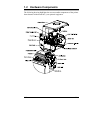
12 I-Class
resulting in a darker image. Conversely, if the image is too dark, reduce this
value.
The final method is to change the ‘Print Control / Print Speed’ menu setting
(also selectable as ‘Print Speed’ in most software programs). Changing the
print speed changes the amount of time the media is under the printhead.
Slower speeds allow more time and control for energy transfer, while faster
speeds will increase throughput, but may require higher heat settings.
;
Note: Heat and Speed settings can be overridden by host software
commands.
You will find that printing barcodes and detailed images on less expensive direct
thermal and thermal transfer media at higher speeds can be tricky. At one heat
setting, the images will fade and at the next higher heat setting, the images will
bleed. This is because the reaction temperature of the media is so high that at
higher rates of speed, it cannot react fast enough. To print fine images at higher
speed, media with lower reaction or release temperatures are required. On the
slower end of the print rate settings, crisper images are possible because the
media is not being stretched beyond its limits.
The following table is intended for reference only (for specific application
information, consult your media specialist or a Datamax Media Representative).
Direct Thermal Media Type Print Speed* Print Energy
Fasson 300 HD Direct Thermal Facesheet
Fasson 300 MD Direct Thermal Facesheet
10-12**
Medium
Thermal Transfer
Media Type
Ribbon
Type
Print
Speed*
Print
Energy
Image
Durability
Great Label TTL GPR Plus
MaxWax
IIMAK Versamark
10-12** Medium Medium
Coated Paper,
Uncoated Paper, Tag
Stock, Some Films,
Some Synthetics
Wax 2 - 10 Low Low
Coated Paper, Glossy
Paper, Tag Stock,
Some Synthetics, Films
Wax/Resin 2 - 8 Medium High
Synthetics, Films Resin 4 - 6 High High
*Values given in inches per second (IPS)
**Highly recommended for optimum print quality at speeds above 10 IPS.


















